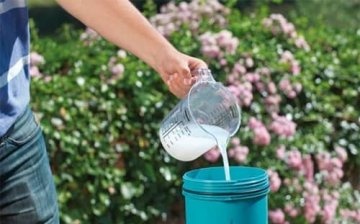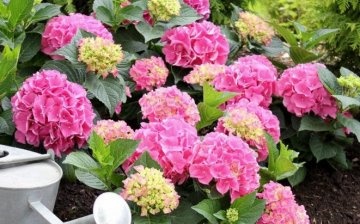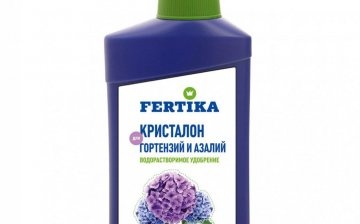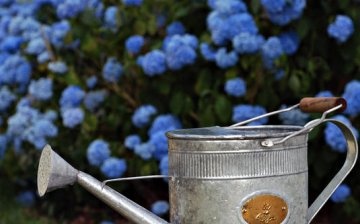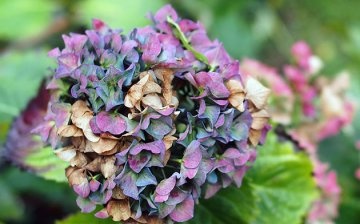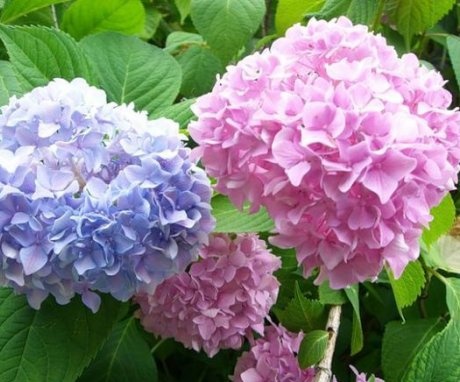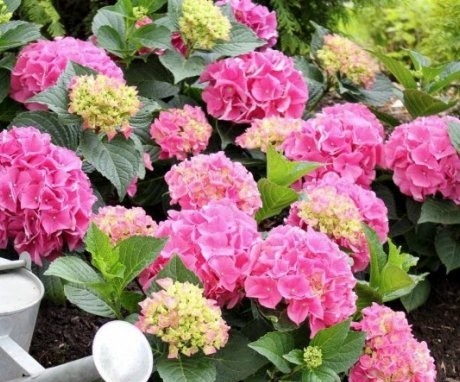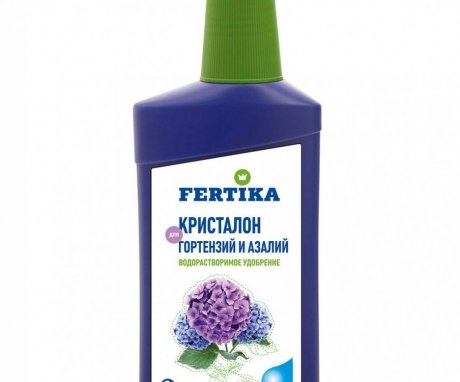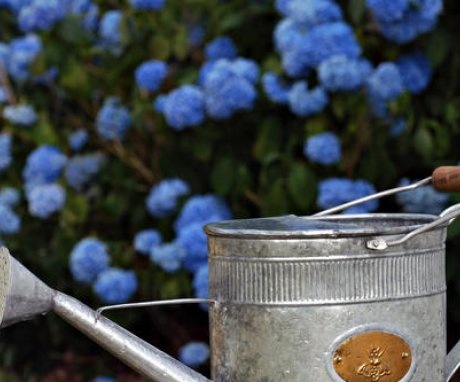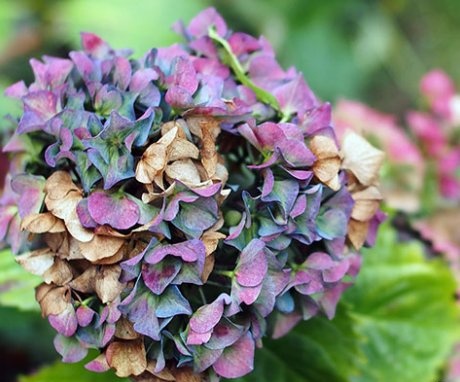Mineral and organic fertilizers for garden hydrangea
Hydrangea has ceased to be exotic in Russian gardens. From the middle of summer, when most of the shrubs and trees have already faded, it delights us with clouds of white, pink or blue inflorescences. To enjoy such splendor until the very frost without harming the plant, you need to know the timing and rules for fertilizing.
Content:
- Description of species and the best varieties
- Spring, summer, autumn feeding: terms and rules
- Mineral fertilizers: a review of preparations
- Organic fertilizers
- What is the danger of a deficit or an excess of fertilizers?
Description of species and the best varieties
Hydrangea Is a separate genus of plants belonging to the Hortensia family. There are about 80 species. Most are shrubs, although there are also small trees and even vines. On Russian sites, three types of shrub hydrangeas can most often be found: paniculate, tree-like and large-leaved "queen of hydrangeas", which is also called garden:
- Hydrangea paniculata (Hydrangea paniculata) is an unpretentious, well-wintering shrub. In our climate, it grows up to 3 meters. Inflorescences are pyramidal (panicle-shaped) can reach 30 cm in length. It blooms in the second half of summer, usually with white flowers, which turn pink by autumn. Most popular varieties: Grandiflora, Vanille Fraise, Lime Light, Great Star. The color of the variety does not change depending on the applied preparations.
- Hydrangea (Hydrangea arborescens) - shrub up to 1.5 m tall. Unpretentious, drought-resistant, in the middle lane winters without shelter. Blooms from late June to autumn. Compared to paniculate hydrangea, treelike hydrangea has larger leaves. Inflorescences can be up to 30 cm, depending on the variety. Popular varieties: Annabelle, Sterilis, Grandiflora.
- Large-leaved hydrangea (Hydrangea macrophylla) is the most popular plant in European gardens. Breeders have bred varieties of various colors and shapes of flowers: white, pink and blue, red and purple, double and needle-like. There are varieties such as Kardinal, Blue Heaven, Ayesha. However, this beauty is not often found in central Russia, and even more so in the Urals and Siberia. Unlike paniculate and tree-like large-leaved hydrangea, it is a thermophilic shrub that requires good shelter even in the southern regions.
Even if the large-leaved hydrangea has not died in winter, flowering may not occur. The fact is that flower buds of ordinary macrophile varieties are laid on the upper part of the shoots, which suffers from frost the most. And for delicate kidneys, negative temperatures are fatal. However, frost-resistant varieties are now appearing, capable of laying buds and blooming along the entire length of the shoot. These include the magnificent varieties of the Endless Summer, Forever & Ever, You & Me series.
Spring, summer, autumn feeding: terms and rules
Hydrangeas prefer slightly acidified soils. Large-leaved hydrangea grows well on neutral soils (pH about 7). The creation of favorable conditions for the plant begins already at the planting stage. The planting pit is made voluminous, 20-25 cm larger in all directions than the size root system... If the soil on the site is not acidic, add peat or pine needles.From fertilizers, superphosphate (glass), potassium sulfate (30 g) are added, with spring planting - additionally ammonium sulfate (30 g).
The first two years are recommended not to feed the plant. Further introduction mineral fertilizers alternate with organic... With all the variety of schemes and drugs, the general rules are as follows:
- nitrogen fertilizing is applied from spring to mid-summer (every two weeks)
- to strengthen the tissues, it is useful to water the bush with a solution of potassium permanganate once a month (0.2 g per bucket of water)
- from the middle of summer, the nitrogen supply is stopped
- during the budding period and then fed with fertilizers with a predominance of potassium
- from the end of August, all feeding stops
Interesting! Some gardeners advise feeding the hydrangea with a complex mineral fertilizer in a diluted concentration for the first few weeks after planting. This applies to those seedlings that came from Holland and were kept on drip irrigation. With this method of cultivation, the roots of the plant are not adapted to the intake of nutrients from the soil, and a sharp change in the maintenance regime can seriously undermine the seedling's immunity. With the help of dressings, the transition to a regular diet will be more gentle.
Hydrangeas are responsive to fertilizers. If it is not possible to apply them regularly, in early spring, immediately after the snow melts, complex granular fertilizers can be embedded in the soil once, which will be consumed gradually and provide the plant with mineral nutrition for the entire season (or even 2-3). In this case, additional mineral fertilizing should not be carried out!
Important! An interesting feature of large-leaved hydrangea is the ability to change color depending on the composition of the soil.
The inflorescences will turn from pink to blue if you water the bush with a solution of potassium alum (5 g per 1 liter of water). 2 liters of solution is enough for one plant. You can also use special color-changing preparations that are now sold at any gardening store. The procedure is carried out every two weeks, starting from the period of bud formation. This transformation can be done, for example, with the following varieties of large-leaved hydrangea: Blaumeise, Nikko Blue, Bodensee. White varieties do not change their color.
Mineral fertilizers: a review of preparations
As mineral fertilizers, you can use individual preparations or use complex ones. The second option is much easier, since you do not need to measure and calculate the proportions, but you just need to follow the instructions (dilute with water and water or embed in the soil).
There are many complex fertilizers on the market today. Products under the brands Fertika, Pokon, GreenWorld received excellent reviews from gardeners:
- Under the Fertika brand for hydrangeas, a specialized liquid fertilizer is produced, which must be applied every two weeks for the entire growing season, and a complex granular fertilizer for evergreens, which is applied 1-2 times per season to the soil according to the crown projection.
- Pokon brand products are classified as long-lasting fertilizers. Once a season in the spring, it is scattered around the bush and mixed with soil, then the plant is watered.
- Fertilizer GreenWorld for rhododendrons and hydrangeas is applied once every 3 months (that is, 1-2 feeding per season). The action of the drug is aimed at increasing the number of buds, more lush flowering, bright color of inflorescences.
If you choose traditional mineral fertilizers for hydrangeas, then until mid-summer (in May-June) you can use ammonium sulfate and potassium sulfate (60 g and 15 g per bucket of water, respectively) and superphosphate (20 g per bucket of water). One bush requires 2-3 buckets of solution. When buds appear, potassium sulfate superphosphate is used (40 g and up to 60 g per 10 l of water, respectively).
Organic fertilizers
As already mentioned, mineral nitrogen fertilizers can be alternated with organic ones. Well suited for these purposes:
- slurry (proportion 1:10)
- infusion of greens (for example, nettle, it is possible with the addition of sorrel)
- mullein solution (3 kg per 10 liters of water)
- liquid Biohumus
In the fall, it is good to add humus under the bushes. First, it will warm the roots from frost, and over the winter it will turn into an excellent nitrogen fertilizer for hydrangeas.
Important! Ash should not be added under the hydrangea, it alkalizes the soil. The introduction of ash is justified only if the soil on the site is too acidic.
What is the danger of a deficiency and excess of fertilizers?
If the plant lacks nutrients, it signals this with its appearance. In general, with a lack of fertilizers, the plant grows slowly, does not bloom or blooms a little:
- Lack of acid in the soil can cause chlorosis of hydrangea leaves. The leaves turn pale, turn light yellow. The medicine is simple - once every 10 days, water the bush with a solution of iron-containing salts, for example, ferrous sulfate (5-6 g of substance per bucket of water). Citric and oxalic acids acidify the soil well (1 tsp per 10 liters of water when irrigated).
- Are the leaves covered with dark spots during flowering? Most likely, hydrangeas are deficient in potassium. One tablespoon of any potash fertilizer per 10 liters of water will correct the situation. And remind you, no ash!
The gardener's golden rule is that lack of fertilizer is better than too much. The lack of some elements can be quickly identified and filled. The consequences of over-fertilization are not so easy to fix:
- Excess nitrogen prevents the plant from properly preparing for winter, reduces its frost resistance. And this threatens that in the spring the gardener will miss some bush on the site. Freezing of the buds will affect future flowering.
- In addition, excess nitrogen delays flowering, directing all the forces of the plant to build up the green apparatus.
- Excessive fertilization with insufficient watering increases the concentration of salts in the soil, due to which the roots, especially the young ones, suffer.
- Excess potassium causes premature yellowing of leaves, deterioration of flower color.
- With an excessive amount of phosphorus in the soil, the plant assimilates iron, zinc and other trace elements worse, becomes more sensitive to a lack of moisture.
- Excess calcium from hard water leads to potassium and magnesium deficiencies, etc.
When fertilizing (if this does not contradict the instructions), the plant must first be thoroughly watered with plain water so as not to burn the roots, and then with a solution of fertilizers. Before fertilizing, make sure the hydrangea needs it. Any calculation of doses of drugs should be based on the analysis of the soil of a particular site and on the condition of the plant.
Generally, hydrangea is considered an unpretentious plant. This is especially true for paniculate or tree-like forms. However, she gratefully responds to reasonable feeding and pleases caring gardeners with lush and long flowering.
More information can be found in the video:



